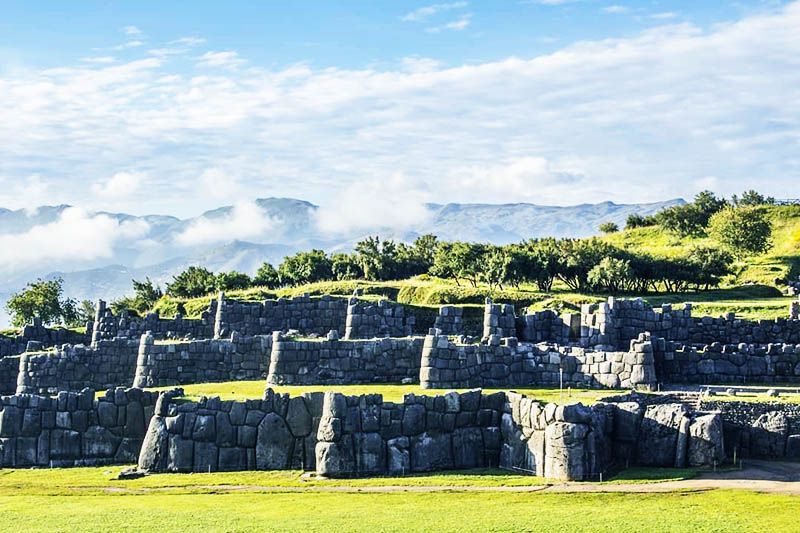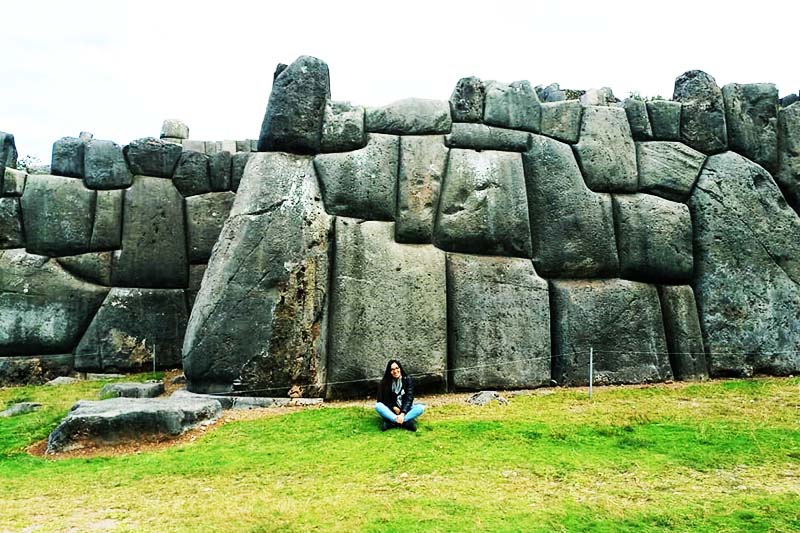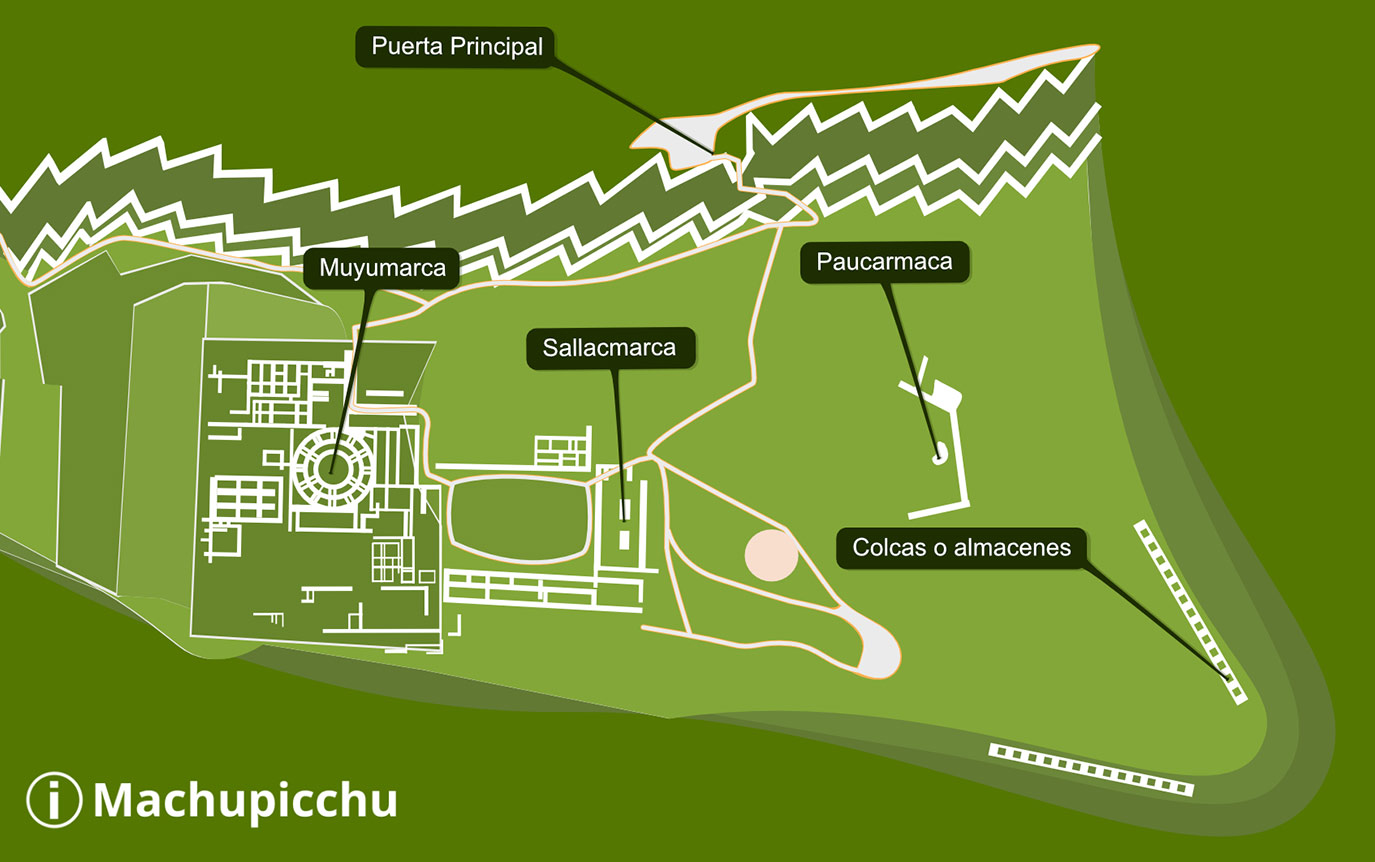Sacsayhuaman: interesting facts and information
The fortress of Sacsayhuaman (‘Place where the falcon is satisfied’) is an Inca archaeological site located in Peru, just 2 kilometers from the city of Cusco and 3,700 meters above sea level (m.a.s.l.). According to the Peruvian chronicler Garcilaso de la Vega, the site is “the greatest architectural work done by the Incas during their heyday”. Its construction was begun by the Inca Pachacutec in the 15th century and completed by Huayna Capac in the 16th century. In 1536, Manco Inca, leader of the Inca resistance of Vilcabamba, fought the Spaniards in this enclosure. Due to the destruction caused by the conquistadors, only 20% of the architectural complex can still be seen today.

View of the fortress of Sacsayhuaman
Location, climate and more basic information
Where is Sacsayhuaman?
Sacsayhuaman is 2 kilometers from Cuzco. It sits next to the Tullumayo River on the side of a hill surrounded by snow-capped mountains such as Ausangate, Pachatusán and Cinca. Due to its high location, from there you can see the city of Cusco. It is currently located next to the archaeological sites of Qenqo, Puca Pucara and Tambomachay.
Climate and altitude
Sacsayhuaman, like Cuzco, is dry and temperate. The average annual temperature is 12°C. Due to its altitude, at 3,700 m.a.s.l., almost 300 meters higher than the ‘Imperial City’, nights are colder and days are hotter. There are 2 seasons during the year. The first is the rainy season (from November to March) where there is more rainfall. The second is the dry season (April to October) where rainfall decreases considerably.
How to get there?
There are several ways to get there. Ascending on foot takes 1 hour from the Plaza de Armas of Cusco. By cab the trip takes 15 minutes. It is also possible to get there by public service, you only have to take some of the transport lines that will take you there in approximately 30 minutes. However, the most common way to get there is by hiring the City Tour service, which includes transportation and guide service to this and other tourist sites.
Price and entrance ticket
Access to Sacsayhuaman is included in the Cusco Tourist Ticket. This ticket also allows access to other archaeological sites such as Qenqo, Tambomachay, Puca Pucara and Coricancha. The price of the Partial Ticket is 70 soles.
Historical information
Who built it?
According to several studies, it is estimated that long before the Incas there were already buildings in Sacsayhuaman. However, the apogee and the immense constructions that can still be seen today were initiated by the Inca Pachacutec (15th century) and concluded by Huayna Capac (16th century).
What was it built for?
Due to its location on top of a hill at the highest point of the city of Cusco, it is believed that the purpose of such an immense construction was as a fortress. In 1536, the site was the scene of resistance by the rebellious Incas of Vilcabamba. However, according to several chroniclers, the site was built as the Temple of the Sun. According to the chronicler Garcilaso de la Vega: “…because they said that it was a messenger of war and not of peace, that the fortress was the House of the Sun”.
How was it built?
It is estimated that the construction took more than 70 years and required up to 20,000 men. Stone quarries located 20 kilometers from the site were used for its construction. The stones that are superimposed on the main wall can weigh up to 100 tons approximately. How did they manage to join rocks of that size so perfectly? It is still a mystery.

Gigantic stone walls found in Sacsayhuaman
Interesting facts
The puma’s head
According to the Andean cosmovision, urban or religious centers of importance harmonized urbanistically with their natural surroundings. Machu Picchu, for example, has the shape of a bird. According to several investigations, the city of Cusco was once shaped like a puma. The fortress of Sacsayhuaman would form the head of the feline while the Temple of the Sun or Coricancha, the genitals.
Demons and extraterrestrials?
In the archaeological complex there is a stone formation formed by large stones assembled together like a puzzle. The perfection of this and other constructions caused the astonishment of the Spaniards during the conquest. According to the chronicles, they attributed its creation to demons. Today, according to oral tradition, these buildings were the work of extraterrestrials.
Temple or fortress?
According to several chroniclers, Sacsayhuaman was built as a religious temple. In its main temple, religious ceremonies were held in honor of the sun, the most important divinity of the Incas. In 1536, the site was the scene of an attack by the rebel Incas of Vilcabamba who sought to recover the city of Cusco. Fearing another possible attack, the Spaniards destroyed a large part of the site. Today, the archaeological site celebrates the Inti Raymi (Festival of the Sun), staged as a tribute to the Inca ancestors.
The resistance and the martyr Cahuide
One of the most amazing constructions of the archaeological complex are the towers. One of these, known as Muyucmarca, was the scene of one of the most symbolic historical events during the Inca resistance. There, the Inca warrior Titu Cusi Huallpa (known as Cahuide), knowing he was defeated by the European conquerors, threw himself from the tower to avoid being taken prisoner by the victors. Today this site is called the ‘Cahuide Tower’.
Subway path to Coricancha?
There is an unsubstantiated story at Sacsayhuaman. It is about a subway tunnel or ‘chincana’, which communicates the immense fortress with the Temple of the Sun or Coricancha. In reality there is no convincing evidence to corroborate the rumors. In the site there are 2 of these underground caves. The first is narrow, small and visitors are allowed access. The second, the ‘chincana’ that supposedly connects to the Coricancha, is longer but is off-limits to the public. According to several stories, the people who ventured in have never returned.
Inca Toboggans?
Among the numerous tourist attractions inside Sacsayhuaman are towers, enclosures, bastions, gates and even Inca thrones. However, one of the most popular areas, without a doubt, are the Inca rock formations or slides. This natural rock formation is currently used by travelers to slide as a swing. The function it had for the Incas is uncertain.
Qenqo, Tambomachay and Puca Pucara
Near the site are the archaeological ruins of Qenqo, Tambomachay and Puca Pucara. All of these sites are known as the Sacsayhuaman Archaeological Park. Admission to these four tourist attractions is included in the Cusco Tourist Ticket. The Tour to this complex covers these sites in addition to the Coricancha, the Plaza de Armas and the White Christ, from where you can appreciate all the beauty of the ‘Imperial City’.
This is the fortress of Sacsayhuaman!
The archaeological site of Sacsayhuaman was one of the urban and religious centers of the Inca empire. This architectural monument is made of stones weighing more than 120 tons. How did the Incas put these stones together without modern technology?
Advice from people who have been there
 By: Pedro C.
By: Pedro C.“Imposing site equal or more than Machu Picchu!“
“Although it appears in all tours as a must-see place, I was very surprised by the imposing and detailed finishing of the stones, which are even more perfect than those you can see in Machu Picchu. Truly a must-see!“
By Ticket Machu Picchu – Last updated, July 22, 2024
